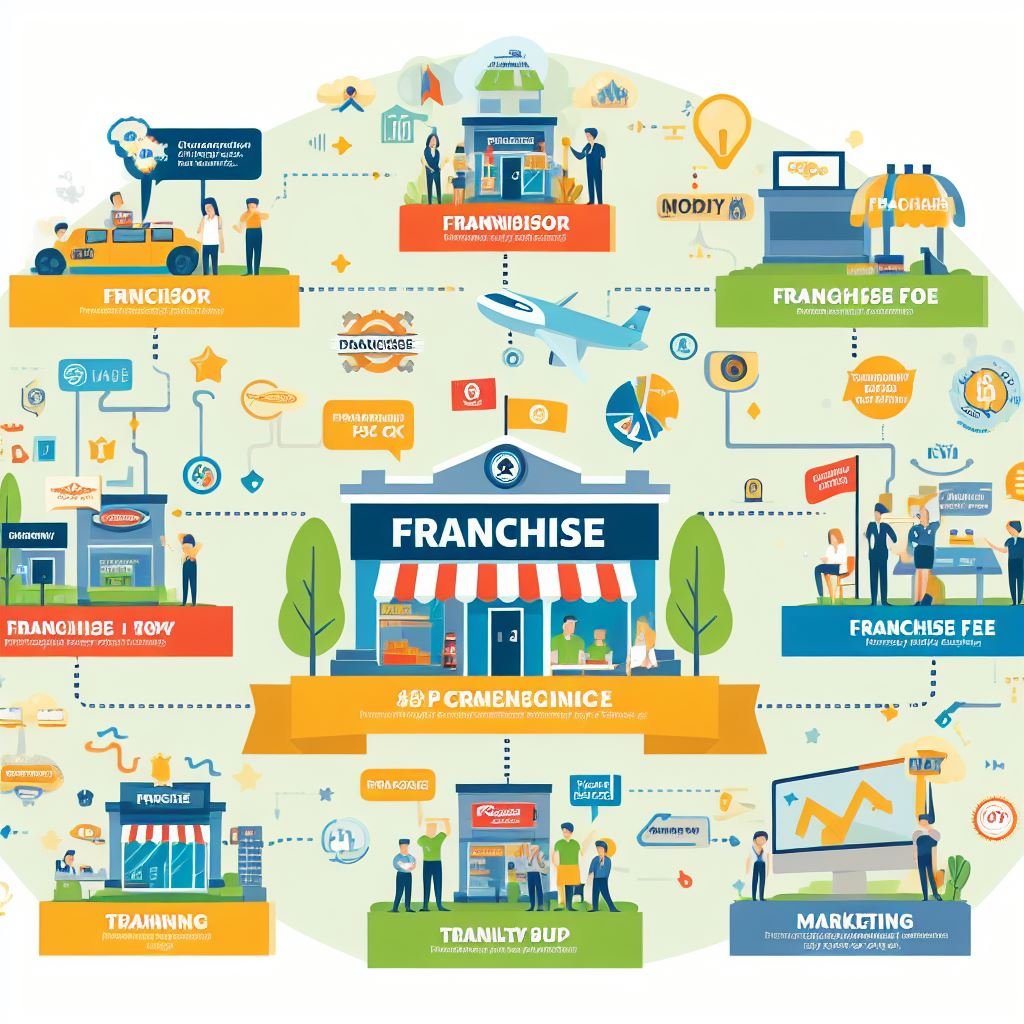This blog will explore the advantages of the Franchise Business Model from the perspective of both the franchisor and the franchisee. Additionally, it will discuss the types of Franchise business models available for various industries and their associated fees and costs.
The franchise business model offers several benefits for both franchisors (the parent company) and franchisees (individual business owners who operate under the brand). Here are some key advantages:
- Established Brand Recognition: Franchisees benefit from the established brand recognition and reputation of the franchisor. This can lead to a faster start-up phase and quicker customer acceptance.
- Proven Business Model: Franchise systems often come with a proven and successful business model. Franchisors have typically refined their operations, marketing strategies, and product or service offerings, reducing the risk for franchisees.
- Training and Support: Franchisees receive training and ongoing support from the franchisor. This support can include assistance with site selection, initial training for the business owner and staff, operational guidance, marketing support, and more.
- Economies of Scale: Franchisors can achieve economies of scale in purchasing, marketing, and other business operations. This can result in cost savings that are passed on to franchisees, allowing them to benefit from lower costs than if they were operating independently.
- Access to Technology and Innovation: Franchisors often invest in research and development to stay competitive. Franchisees can benefit from access to new technologies, innovations, and improvements in products or services that the franchisor introduces.
- Marketing and Advertising Support: Franchisees benefit from collective marketing efforts and advertising campaigns initiated by the franchisor. This can include national or regional advertising, as well as promotional materials and strategies designed to boost brand awareness.
- Risk Reduction: Franchisees operate under a proven business model with a track record of success, reducing the risk associated with starting a new business. Franchisors may also provide guidance on avoiding common pitfalls.
- Exclusive Territories: Franchise agreements often grant franchisees exclusive territories, limiting competition from other franchisees of the same brand in nearby areas. This can help protect the franchisee’s market share.
- Access to Vendor Relationships: Franchisees can benefit from pre-established relationships between the franchisor and suppliers or vendors. This can lead to better deals on supplies, equipment, and other necessary resources.
- Community and Networking: Franchisees can connect with a network of fellow business owners within the franchise system. This sense of community provides opportunities for sharing insights, experiences, and best practices.
- Proven Marketing Strategies: Franchisees can leverage the successful marketing strategies developed by the franchisor. This includes standardized branding, advertising materials, and promotional campaigns that have proven effective in other locations.
There are several types of franchise models, each with its own characteristics and structures. The main types include:
- Product Distribution Franchise:
- Description: In this model, the franchisee sells the franchisor’s products, often with exclusive rights in a specific territory.
- Example: Soft drink bottling companies.
- Business Format Franchise:
- Description: This is the most common type of franchise, where the franchisee uses the entire business format of the franchisor, including the brand, trademarks, business methods, and ongoing support.
- Example: Fast-food chains, retail outlets.
- Management Franchise:
- Description: The franchisee operates the business using the franchisor’s brand and business model, but the franchisor provides ongoing support in areas like marketing, operations, and overall management.
- Example: Hotel chains.
- Conversion Franchise:
- Description: Existing businesses convert to a franchise model, adopting the branding, systems, and support of the franchisor.
- Example: An independent hotel converting to a franchise hotel.
- Single-Unit Franchise:
- Description: The franchisee operates a single unit of the franchised business.
- Example: A single fast-food restaurant.
- Multi-Unit Franchise:
- Description: The franchisee operates multiple units of the franchised business in a given territory.
- Example: Owning and operating several outlets of a coffee shop in the same city.
- Area Development Franchise:
- Description: The franchisee is granted the right to open multiple units within a specific geographic area. They are typically required to develop a certain number of units within a specified timeframe.
- Example: Opening several branches of a fitness center in a designated region.
- Master Franchise:
- Description: The master franchisee is granted the right to develop, sub-franchise, and sell franchises within a specified territory.
- Example: A master franchisee might own the rights to an entire country or a region and can sub-franchise to others.
- Joint Venture Franchise:
- Description: The franchisor and franchisee form a partnership to establish and operate the franchise business.
- Example: A local entrepreneur partners with an international brand to bring their franchise to a new market.
- Co-Branding Franchise:
- Description: Two or more franchises collaborate to offer complementary products or services under one roof.
- Example: A restaurant that combines the menus of two different fast-food franchises.
- Home-Based Franchise:
- Description: The franchisee operates the business from home, typically with lower overhead costs.
- Example: Home-based consulting or service businesses.
The fees and royalties associated with a franchise can vary widely depending on the specific franchise system, industry, and business model. Here are some common types of fees and royalties that franchisees may encounter:
- Franchise Fee:
- Description: A one-time, upfront fee paid to the franchisor for the right to use their brand, trademarks, and business model.
- Typical Range: Can vary significantly but may range from a few thousand to several hundred thousand dollars.
- Royalty Fees:
- Description: Ongoing payments made by the franchisee to the franchisor, usually calculated as a percentage of the franchisee’s gross sales.
- Typical Range: Typically ranges from 4% to 8% of gross sales, but can vary.
- Advertising Fees:
- Description: Payments made by the franchisee to contribute to the franchisor’s national or regional advertising and marketing efforts.
- Typical Range: Typically ranges from 1% to 3% of gross sales.
- Renewal Fee:
- Description: A fee paid by the franchisee when renewing the franchise agreement for an additional term.
- Typical Range: Can range from a few thousand to tens of thousands of dollars.
- Transfer Fee:
- Description: A fee paid by the franchisee when transferring the ownership of the franchise to another party.
- Typical Range: Can range from a few thousand to tens of thousands of dollars.
- Training Fees:
- Description: Some franchisors charge fees for initial training provided to franchisees and their staff.
- Typical Range: Varies by franchise, and some franchisors include training in the initial franchise fee.
- Technology Fees:
- Description: Fees for the use of the franchisor’s technology, software, or point-of-sale systems.
- Typical Range: Can vary, and some franchisors may include this in the royalty fee.
- Supplier Rebates:
- Description: Franchisees may be required to purchase supplies, equipment, or inventory from approved suppliers. The franchisor may receive rebates or discounts from these suppliers, which can offset franchise fees.
- Audit Fees:
- Description: Franchisors may reserve the right to audit franchisee financial records to ensure compliance with the terms of the franchise agreement. If discrepancies are found, the franchisee may be responsible for audit costs.
The franchise model provides a range of advantages to potential franchisees, however, it is essential that they review the franchise agreement carefully and comprehend the obligations and responsibilities that are attached to the arrangement. There are various franchise models available to entrepreneurs, each tailored to their individual preferences, investment abilities, and business objectives. It is important for prospective franchisees to thoroughly research and comprehend the terms and conditions of each franchise model prior to entering into any agreement. Furthermore, it is essential for franchisees to review the Franchise Disclosure Documents (FDDs) and the Franchise Agreement to ensure they are aware of all applicable fees and royalties. It is also recommended that franchisees seek legal and financial counsel prior to signing any franchise agreement, to ensure they are fully aware of the financial commitments and potential returns. The terms and conditions of a franchise agreement may vary significantly from franchise to franchise.
There are many other Innovative Franchise Models that we have created. If you want to grow your business with this model then don’t hesitate to get in touch with us. CONTACT

